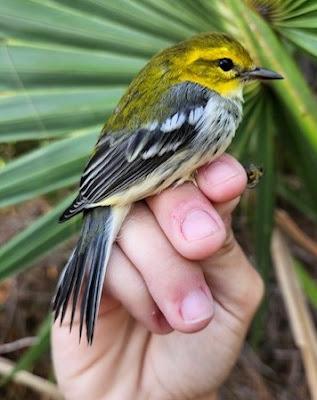CAPTAIN SAMS
As we began our small trek from the beach to our station, we heard a familiar beep from our radio telemetry antennae... the Bobcats are back! We followed a radio-collared individual for a good portion of the morning, monitoring a few nets nearby. This proved to be an easy task on a slow day, with 22 new birds banded and 9 recaptures.
Radio Telemetry is a helpful technique for tracking animal movement and behavior. It can be used on a variety of species, since transmitters can be specially sized and fitted; Bobcats wear their transmitters as a collar, turtles get tagged on their shell, and there are a variety of harness styles available for birds big and small.
On Kiawah Island, Bobcats are monitored with the goal of identifying habitat use patterns through the day and night, locating dens, as well as collecting information on their survival and dispersal. Read more about this local project here.
 |
| 3 Element Yagi antennae and receiver |
We use a Yagi antennae to pick up signals from the transmitter. The antennae needs to be tuned to a frequency that is only emitted by the study animal. A receiver is attached, which helps the user collect bearings by playing a "beep" signal that increases in volume when the antennae is pointed towards the study animal. A numerical value is also shown on the receiver to further indicate distance from the signal source.
Despite the limited bird activity, today was well spent brushing up on a research staple skill!
-Lisa Viviano
LITTLE BEAR
We were greeted this morning with a heavy layer of fog over the golf course which gave us a great spooky season October feeling. Luckily the fog burned away as the sun rose, and revealed a beautiful sunrise out on the beach. Our first two net runs yielded us about 30 birds but things slowed down drastically after that. Overall we caught slightly less birds than yesterday (28 new and 9 recaptures for a total of 37). We caught many of the usual characters, including the increasingly common Yellow-rumped Warblers, the classic Gray Catbirds, and a lone Common Yellowthroat. We also caught 4 Swamp Sparrows and 2 Song Sparrows, I am a huge sparrow fan so I'm always happy to see some coming through the station.
 |
| Swamp Sparrow (after-hatch year, sex unknown) |
Most of the neotropical migrants have already made their way past South Carolina but we are still catching a few stragglers here and there, including a Black-throated Blue Warbler that we caught today. As the season progresses these birds will become even rarer until eventually they have all made their way through, but it is always fun to catch a few individuals who are running a bit late. As winter creeps ever closer I am excited to see what other species we will catch!
- Natalie
| Species | Captain Sam's | Little Bear |
|---|
| New | Recaps | New | Recaps |
|---|
Yellow-billed Cuckoo | - | - | 1 | - |
Eastern Phoebe | 1 | - | 1 | - |
Carolina Chickadee | - | 1 | - | - |
Ruby-crowned Kinglet | 1 | - | - | - |
House Wren | 2 | - | 2 | - |
Carolina Wren | - | - | - | 1 |
Gray Catbird | 1 | 3 | 6 | 6 |
Hermit Thrush | - | - | 1 | - |
White-crowned Sparrow | 1 | - | - | - |
White-throated Sparrow | 1 | - | 1 | - |
Song Sparrow | - | - | 2 | - |
Swamp Sparrow | - | - | 4 | 1 |
Ovenbird | 1 | - | - | - |
Common Yellowthroat | 1 | 1 | 1 | - |
Black-throated Blue Warbler | - | - | 1 | - |
Western Palm Warbler | - | - | 1 | - |
Myrtle Warbler | 11 | 3 | 8 | - |
Northern Cardinal | 2 | - | - | 1 |
| Today's Banding Stats | Captain Sams | Little Bear | TOTAL |
|---|
| # Birds Banded | 22 | 28 | 50 |
| # of Recaptures | 9 | 9 | 18 |
| # of Species | 12 | 13 | 18 |
| Effort (net-hours) | 137.6 | 136.5 | 274.1 |
| Capture Rate (birds/100 net-hours) | 22.5 | 27.1 | 24.8 |
| # of Nets | 32 | 26 | 58 |
|
| 2024 Fall Cumulative Banding Stats | Captain Sams | Little Bear | TOTAL |
|---|
| # Birds Banded | 4,504 | 2,931 | 7,435 |
| # of Recaptures | 975 | 800 | 1,775 |
| # of Species | 85 | 81 | 99 |
| Effort (net-hours) | 11,684.65 | 7,160.80 | 18,845.45 |
| Capture Rate (birds/100 net-hours) | 46.9 | 52.1 | 49.0 |
| # of Days | 71 | 61 |
|
Banding Staff
Aaron Given (CS)Natalie Miller (LB)
Lisa Viviano (CS)
Noah Nei (LB)
Note: All banding, marking, and sampling is being conducted under a federally authorized Bird Banding Permit issued by the U.S. Geological Survey’s Bird Banding Lab.







